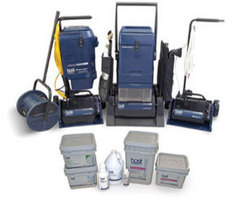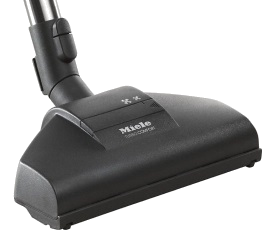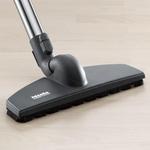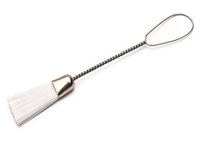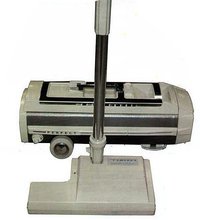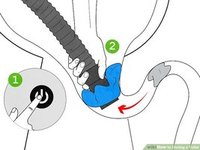
Vac Tips are generated from customer questions and are intended for staff training and customer reference material. We welcome your questions and topic proposals. Please submit your topics and question using the contact button. We want to share this information.
Have a problem? email: napasewandvac@gmail.com, call 707.224.2922, or submit your questions using the form at the bottom of this page.
- Why a New Vacuum May Clog...
- Vacuum Cleaner or Vacuum Dirtier?
- Vacuum Cleaner Tune-Ups
- The Cost of Vacuum Cleaner Repair - ?
- Change your vacuum belt?
- Bags or Bagless?
- HEPA Vacuum Cleaners!
- How long will your vacuum last?
- What is a HEPA Filter?
- Turbo Tools - How effective are they?
- Berber carpet - best cleaning results...
- CRAZY CLEAN !
- Bee's Wax
- Solid Filter Air Purifiers
- Air Cleaning Machines
- Carpet Cleaning Methods
- Dry Cleaning Carpets
- Tool Maintenance
- DUST MITES
- Electrolux Vacuum Cleaner? Not...
- What is the Miele Automatic Vacuum Feature?
- Miele Triflex Getting Started Introduction: How to charge the battery for the first time.
- Triflex HX1: Cleaning the pre-filter
- Triflex HX2: "Comfort Clean" Filter Maintenance
- Triflex HX2: Filter maintenance and removal
- Triflex: Cleaning the roller brush Part 1
- Triflex: Cleaning the roller brush Part 2
Vacuum Cleaner or Vacuum Dirtier? - by Russell Moore 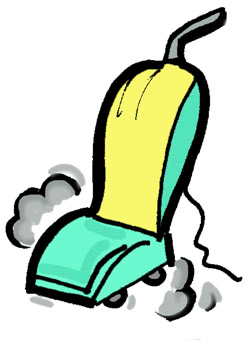
Is your vacuum cleaner a "vacuum cleaner" or a "vacuum dirtier?" If your vacuum cleaner produces an exhaust particle count larger than the ambient air quality, then you own a "vacuum dirtier." This test can be performed with a particle counter. First measure the room air quality. Turn on your vacuum cleaner and measure the exhaust air quality. Compare! If the vacuum cleaner exhaust air measures a higher number, your vacuum cleaner is making your house dirtier. Bring your vacuum in for a free analysis!
Allergy and asthma victims can use this information when shopping for a new vacuum cleaner. The right vacuum will capture lung damaging particles that can aggravate allergies and asthma. Ask our consultant about alternative products or accessories for your current vacuum that may improve performance and exhaust air quality. Vacuum exhaust air quality is determined by the filtration system. The primary filter is the storage bag. The Miele Company has devoted massive resources to improving the vacuum storage bag performance and air quality. Many synthetic bags are on the market today but not all are created equal. Miele technology has improved performance, storage capacity and air quality. Add a Miele HEPA filter to Miele’s "sealed system" and you get immaculate exhaust air. Your vacuum cleaner will clean your home and the air you breathe.
Unlike machines using filters only, installing a fresh bag will renew performance. To empty the dirt container will leave a contaminated filter producing diminishing performance. 3m makes Filtrete, an outstanding filter material used in making quality home furnace filters and vacuum bags. A $15 Filtrete heating and air conditioning filter every 2 months should do the trick. Add a Room Air Purification System to eliminated lung damaging particles continuously. To protect your furnace filter investment, ask your vacuum dealer if they supply Filtrete bags or "HEPA" Synthetic bags for your brand vacuum cleaner. If not, he may be able to order them.
Vac Tune-Ups - $69.95-$89.95 - by Russell Moore 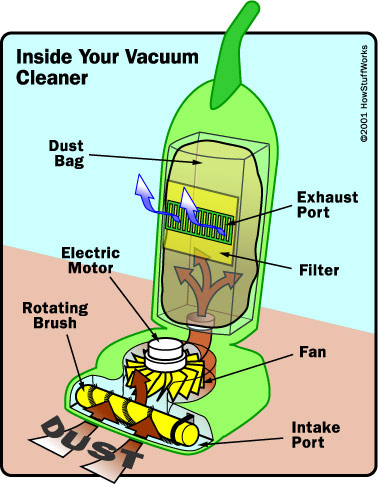
A vacuum tune-up is a maintenance procedure and not a repair. Change your bag regularly and change the belt at least once a year. The belt need not be broken to be ineffective. 80% of the performance is derived from agitation. Most vacuum cleaners use a rubber belt to turn the brush roll. The belt tension determines how aggressive the brush roll will agitate the carpet. The heat from the motor pulley and brush roll pulley is enhanced by the brush roll's friction with the carpet. The heat translates to the rubber belt, softens and relaxes the rubber. The belt eventually adopts the shape into which it has been stretched. The old belt will not turn the brush against the carpets resistance. The result is less agitation. Agitation is needed to dig the embedded dirt and break the seal between the vacuum cleaner rug plate and the carpet. This allows air to circulated through the vacuum agitator housing and sweep the dirt into the air stream that flows into the vacuum bag (or container for bagless models). Installing a new belt will renew the airflow. A good quality vacuum bag will improve air flow. A new filter will improve air flow. Tune-Up procedure: Remove the rug plate (brush roll cover) to replace the belt. Now you can remove the brush roll. Clean the brush roll, removing the thread, carpet yard, hair, and string that crush the brushes. Remove the end caps and clean the hair and debris from under the caps and around the bearings and bushings. Clean or replace the bearings or lubricate them as needed. Get some "Crazy Clean" to clean the grime from the brush roll cylinder. "Crazy Clean" the brush roll housing and the rug plate. Now your ready to install the new belt. Loop the belt around the motor pulley, loop it around the brush roll and then press the brush roll into its position in the agitator housing. Replace the rug plate and you're ready to vacuum. Remember, "a new broom sweeps clean." Well, your "broom" is not new but for $69.95 it will clean as good as new. Regular Tune-Ups will provide other benefits as well. This yearly service will prevent repair incidents, extend the life of your carpet and improve the appearance of your home. The right vacuum cleaner will reduce collateral dusting. Have your dealer test your vacuum cleaner exhaust emissions during your tune-up visit. This test will reveal whether or not your vacuum cleaner is a "vacuum cleaner or vacuum dirtier". NOTE: Ask your dealer about vacuum cleaners that don't require belt changes.
Carpet Cleaning Methods - Shampoo, steam cleaning, wet extraction Carpet Cleaning Methods - Shampoo, steam cleaning, wet extraction and drycleaning- by Russell Moore
The Hoover steam vacs are not shampooers. The industry refers to this classification as extractors, steam vacs or steam cleaners. The Hoover Max 50/6/70 uses detergent and water to dissolve the soil. The Max Extract then vacuums the dirty water to remove the soil.
A shampoo machine is like the Koblenz. Generally they use rotary brushes. Some, like the Kirby, use a different brush technique but use a cleaning formula based on "shampoo" that drys into a crystal. The crystal captures the soil and is extracted by the vacuum. Shampoo machine clean by capturing soil in the shampoo and a vacuum cleans out the residue when dry.
Every Carpet Cleaning Machine Manufacturer has a line of chemicals they sell along side their hardware. Hoover will void your warranty if you do not use their chemicals. The Hoover Steam Vac requires a low suds detergent because the motor can suck suds into the motor compartment. Moisture from suds causes motor corrosion and bearing damage. Rug Doctor uses anti-foam so that the recovery tank won't fill with foam produced by recovering carpet shampoo. Anti-foam may not be needed if the carpets have never been shampooed.
Shampoo is a different process than steam detergent. Household Shampoo machines, most made by Koblenz, are still available and do their best work as a floor scrubber/polisher. These machines are very affordable and are often purchased for cleaning tile and grout. The machine uses counter rotating brushes that that separate the soil from the carpet using the shampoo as a vehicle. The shampoo suds captures the soil and dry into the form of a crystal. Your vacuum cleaner then extracts the crystal during subsequent vacuuming to remove the soil from your carpet.
The Oreck Orbiter is another floor machine, similar to commercial single brush models. Oreck and Koblenz can be used to apply Dry Cleaning Product as well. Oreck sells Capture brand dry carpet cleaning material. Sebo has their own brand of dry cleaning material. Host has its own cleaning material. Any of these cleaning brands can be interchanged with the machine of your choice. The dry cleaning material's performance my differ in each application. My experience is that Host is the most versatile and most effective for varying carpet soil conditions. These materials can also be used to clean tile and grout.
The Hoover Floor Mate and Hoover Steam Vac use the wet extraction method. These machines scrub linoleum, tile, carpets and furniture plus extracts the dirty water (using a vacuum process), leaving your floors and grout lines clean and dry! For more information, view our training video on our Hoover products page or contact Napa Sew & Vac. View training videos on You Tube: https://youtu.be/JHkqVXai2lo.
HEPA Vacuum Cleaners! - by Russell Moore ![]()
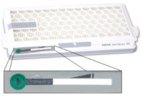
Solid Air Filter Purifiers - by Russell Moore 
Air Purification Machines - by Russell Moore 
A turbo tool is an air driven brush roll tool. The turbo is derived from turbine, a small drum with blades that deflects the rushing air developed by the vacuum motor. The turbine is connected to the brush roll with a belt and pulley system. The turbine spins and so does the brush roll.
Bags or Bagless? - by Russell Moore
The house dust mite (sometimes referred to by allergists as HDM) is a cosmopolitan guest in human habitation. Dust mites feed on organic detritus such as flakes of shed human skin and flourish in the stable environment of dwellings. House dust mites are a common cause of asthma and allergic symptoms worldwide. The mite's gut contains potent digestive enzymes (notably proteases) that persist in their feces and are major inducers of allergic reactions such as wheezing. The mite's exoskeleton can also contribute to allergic reactions.
The Cost of Vacuum Cleaner Repair - by Russell Moore 
A Vacuum Cleaner Tune-Up is valuable maintenance but it will not entirely prevent repair incidents. Running over a cord, chewing up the insulation, is a repair that may require a cord replacement. A Broken pile selector, broken handle release lever, broken handle, broken wheels, worn bag assembly, worn dirt cup seals, damaged brush roll housing, broken motor fan, obstructions in the fill tube (clogged hoses), broken cord reels and damaged circuit boards are all examples of failures that may result in a repair expense. Replacing worn parts will extend the life of your vacuum cleaner but it will not guarantee it to have a "new life". The dealer can repair what's needed and will supply a guarantee on the parts replaced and the work needed to make that repair. Normally, a Tune-Up is performed during this process. It is always important that you get a firm estimate from your dealer prior to the repair being completed. The estimate is a time consuming process and requires the dealer to find a solution without actually making the repair. An experienced dealer will have a good idea what the solutions are. He can give you a price range and he will require your approval before he proceeds. Now that you know the approximate cost of the repair, you may want to ask the dealer's opinion regarding the value of the repair versus replacing the vacuum cleaner with a new one. The dealer will give you an honest evaluation of making an investment in the repair and can supply you with a Trade-In value should you decide that maybe you'd like something new. Keep in mind, the Trade-In value will reflect the resale value with the dealer footing the cost for refurbishing plus the dealer must supply the new owner with a guarantee of some type. Napa Sew & Vac offers a one year guarantee on your repair plus we will provide a 30 day grace period during which time you can return your repaired vacuum cleaner and receive your repair cost plus a generous trade-in amount toward your new machine purchase. Napa Sew & Vac offers a 30 day repair warranty on parts and labor.
Change you Vacuum Cleaner Belt - by Russell Moore
The year is 1989. A Saturday morning customer shopping for a new vacuum cleaner compared new models and took notes on pricing. At the end of the day, after comparing prices with every other store in town, she returned informing me that I was going to get her business. We agreed on her trade in value, sight unseen. I carried her new machine to the car, opened the trunk, and to my surprise her trade-in was exactly the same machine, make and model, but 5 years old. Stunned, I lifted her old machine out of the trunk and replaced it with her shinny new one. I shook her hand and thanked her for the business and promised I would find a new home for her old machine. I then recommended that she return her new machine annually for a yearly tune-up.
I performed a tune-up on her old machine. I do not think that she had ever changed that belt. It was stretched out and worn thin. We quickly sold the trade-in. I advised the new owner to change the belts annually. A fresh belt will insure proper belt tension to produce aggressive brush roll performance. The belt is responsible for 80% of an upright’s performance. A Brush Roll service includes cleaning the cylinder, servicing the bushings, lubricating bearings, and cleaning the agitator housing. A $49.95 Tune-Up will make most vacuum cleaners perform like new.
The Original Bee's Wax Old World Formula Furniture Polish @ $14.95
- Tired of your bathroom MIRRORS fogging up? How about your automobile windshield GLASS? This product makes glass seem invisible and prevents fogging and is an excellent glass and mirror cleaner. It is also anti-static and actually repels dust so surface stays cleaner longer.
- This product makes GRANITE, MARBLE, CORIAN and SILESTONE acid resistant to protect from spills of acidic liquids such as coffee, orange juice, etc and is FOOD SAFE for countertops. It is never greasy.
- When used to clean and polish STAINLESS STEEL, it works beautifully and won't fingerprint. It also cleans all other metals like Copper, brass, silver, etc.
- When used on your SHOWER DOORS AND TILE WALLS, it prevents soap scum buildup and the surfaces stay vibrant.
- It also cleans, moisturizes and restores vibrant color to LEATHER FURNITURE, car seats, shoes, purses, etc. with no greasy feel.
- It restores the natural beauty of WOOD FURNITURE, prevents dryness, won't fingerprint, NEVER leaves a wax buildup and requires NO BUFFING.
- This company has been in business since 1974. This product has been featured in New York Social Diary, The Fabricator and The Antiques Roadshow and named the best furniture polish by House Beautiful.
Crazy Clean @ $9.95 19 oz.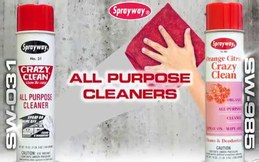
Crazy Clean is a great all purpose cleaner. This formula is used extensively in the sewing and vacuum industry by mechanics and technicians to detail you repairs. Try it at home on windows, stainless steel appliances, cook tops, ovens, kitchen cabinets, sinks, toilets, tubs, cleans your refrigerator and microwave inside and out! Use a sewing machine lint brush to as a detail brush. The work great! You'll get all the nooks and crannies and the results will make you proud.
Electrolux vacuum cleaner of old is not the Electrolux vac you're buying today. Electrolux USA of the 1950"s was a brand name leased from Electrolux of Sweden. The lease expired and Electrolux USA has been rebranded as Aerus. The Electrolux Company own such brands as Eureka and Sanitaire. Their branding their own vacuums and you'll find them widely distributed as Electrolux vacuum cleaners. They're manufactured around the world.
http://www.aerushome.com/about/
"Originally established in 1924 as Electrolux, we began our journey into Healthy Home products with the first tank vacuum model, introduced by Gustaf Sahlin. This tank (also known as canister) design became an overnight sensation and remains a standard of excellence for floor care products.
After opening a manufacturing facility in Greenwich, Connecticut, production on the popular Electrolux vacuum cleaner, Model XXX, began in 1937. As carpeting became more prevalent in buildings during the 1950's, Electrolux introduced the first commercial duty carpet shampooer to the market. After selling nearly 14 million units, Model XXX was retired in 1954 and later recognized by the Smithsonian Institute as one of the top 100 U.S. products.
Over the next several decades, our floor care technology continued to evolve and product offerings expanded. In 1970, a second manufacturing facility opened its doors in Bristol, Virginia to produce several different models of vacuum cleaners and carpet shampooers. In 2000, we transitioned from our floor care roots with Electrolux to offer a full line of innovative Healthy Home products (including air and water purification systems) as Aerus L.L.C. Named after the Greek term for "air," the purpose of Aerus is to help others live well by producing clean, pure air and creating healthier indoor environments."
(The new Aerus canister vacuum unit itself, is in made by Electrolux in Europe. I think the power heads and hoses offered in the US are made in the USA. Dealers around the world have different accessories depending on their power requirements are market.)
HOST DRY EXTRACTION CARPET CLEANING SYSTEM - Russell Moore
We became acquainted with HOST while confronting problems and complaints about wet extraction cleaning methods. While attending a sewing machine seminar at the Emeryville Hyatt, we were taking a break and observed this system being used by the hotel maintenance staff. Our inquiry led to our own HOST distributorship. The process is simple, there are no chemicals to mix. The HOST cleaning material comes in a sealed foil pouch. It is slightly moist material, saturated with a specially formulated cleaning solution. The product is made by Racine Industries in Racine WI. They use a material contrived from a ground corn husk which carries the cleaning material through the carpet pile using a machine resembling a pile lifter. As the brushes spin, it spreads HOST through the carpet. Acting like tiny little sponges, it absorbs dirt and residue. Upon completion, the HOST is removed by vacuuming. The carpet is dry and ready to use. Any material left behind by the initial vacuuming will be removed by subsequent vacuuming. This system is effective on most spots and can be used with a spotting brush for intermittent maintenance. HOST is completely safe and biodegradable! Visit our Host webpage.
What is the Miele Automatic Vacuum Feature?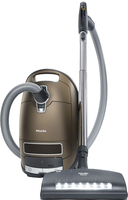
The automatic feature selects the correct motor speed for the application at hand. Running at a lower speed may be more effective than full speed. Lower speeds also use less energy and can save you money while vacuuming.
How does it work?
This can be demonstrated by putting a coin in your hand and placing the vacuum hose over the coin and onto your handy and then turn on the vacuum. No matter how much suction you deliver, the coin will not move. Turn the vacuum off and the coin will still be in your hand. Repeat the test and allow some some air to enter. The coin will fly up the hose when adequate air flow is produced. You see, Suction doesn't clean, it's Air Flow that does the cleaning. Insuring proper air flow is the purpose of the Automatic feature. This smart vacuum feature will reduce air flow to prevent the nozzle or hose from "Sealing", thus producing continuous "Air Flow." The feature is created by using electronic sensors to measure "Air Flow". When the machine senses there's too little air flow, it will automatically reduce the suction to eliminate the resistance. Once the seal is broken and air flow resumes, the vacuum will resume to a constant speed.
You bought a new vac because the old one wasn't doing the job. The result is dirty carpet, full of hair, grit and debris. Should that new vac pickup a toothpick, hair pin, small toy or piece of cardboard, you may end up with a clog. Any obstruction in the fill tube could produce an accumulation of debris resulting in reduced air flow and eventually a clog. Eventually, the fill tube will fill completely and back up to the brush roll result in the vacuum spitting dust out from around the nozzle. In such case, you need to remove the brush roll cover and remove the debris. You'll want to find the obstruction and remove it so it will not plug up the fill tube again.
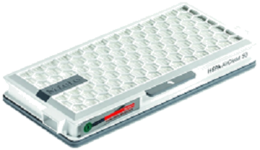
HEPA stands for high-efficiency particulate air. A HEPA filter is a type of mechanical air filter; it works by forcing air through a fine mesh that traps harmful particles such as pollen, pet dander, dust mites, and tobacco smoke. Selecting and Using an Air Filter. You can find HEPA filters in most air purifiers. Dec 4, 2016.
HEPA Filter Benefits for Allergy Relief - WebMD
www.webmd.com/allergies/hepa-filters-for-allergies
WIKI:
High-efficiency particulate arrestance (HEPA), originally called high-efficiency particulate absorber but also sometimes called high-efficiency articulate arresting or high-efficiency particulate air, is a type of air filter. Filters meeting the HEPA standard have many applications, including use in medical facilities, automobiles, aircraft and homes. The filter must satisfy certain standards of efficiency such as those set by the United States
Department of Energy (DOE).
To qualify as HEPA by US government standards, an air filter must remove (from the air that passes through) 99.97% of particles that enter the filter.



